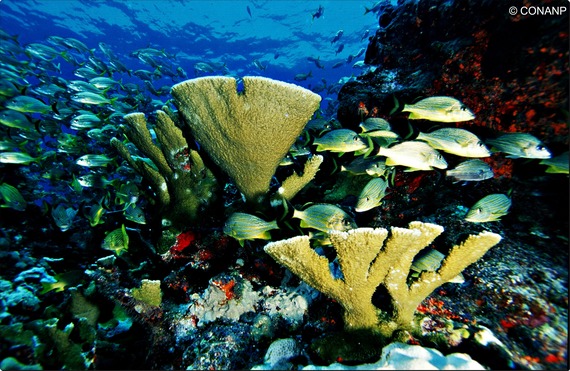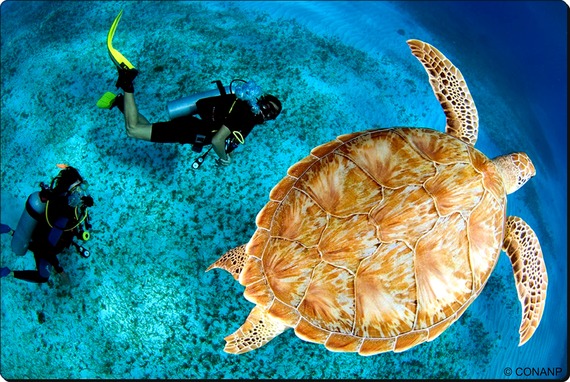Mexico's pledge to establish four new marine protected areas, made at the ongoing UN biodiversity conference in Cancún, Mexico, has boosted efforts to protect the global ocean, further advancing commitments made in the Promise of Sydney at the IUCN World Parks Congress 2014 - Trevor Sandwith, Director of IUCN's Global Protected Areas Programme, writes from Cancún.
Mexican President Enrique Peña Nieto announced the pledge to establish three new marine Biosphere Reserves that will conserve important habitats in both the Pacific and Caribbean, including large parts of the Meso-American Barrier Reef and deep water zones in the Gulf of Mexico, at the 13th Conference of the Parties to the Convention on Biological Diversity (CBD COP13). The pledge will increase marine protection in Mexico to 23%, more than double the 10% target.
In 2010, governments adopted a target of protecting 10% of the global ocean by 2020 - both in territorial waters and the high seas - during CBD COP 10 in Nagoya, Japan. Commitments such as these by Mexico boost our hopes of achieving this target.
Three months ago, protection of the global ocean stood at 4.1%, while marine protected areas within territorial waters had just surpassed 10.2%, as revealed by the Protected Planet Report 2016 launched at the IUCN Congress in Hawai'i.
Major announcements in the intervening months have pushed these numbers even higher so that by 1 December, the protection of the global ocean had exceeded 5% for the first time, and marine protected areas within territorial waters had reached 12.7%, according to the December update of the Protected Planet Report, jointly presented by UNEP's World Conservation Monitoring Centre and IUCN in Cancún. Mexico's new pledge will take this even higher and challenge world leaders to make further efforts.
"We must protect and conserve biodiversity because it contributes to the survival and development of communities" - Mexican President Enrique Peña Nieto
It is certainly leadership that makes the difference. In Sydney at the IUCN World Parks Congress 2014, 14 governments made commitments towards enhancing ocean protection as a part of the Promise of Sydney. These included pledges by several small island states, reinventing themselves in the process as 'large ocean states'.
For example, Palau pledged to restrict commercial fisheries in its entire 200-mile Exclusive Economic Zone while the Comores committed to protecting 7% of all marine and coastal ecosystems, among many others.
Significantly, several of these countries made the case for embedding the conservation of coastal and marine systems at the heart of their economic development strategies. Their commitments were regarded as essential investments in sustaining livelihoods and opportunities into the future.
This argument was not limited to small island states. Several other countries such as South Africa pledged to expand protection over the next decade to ensure environmental sustainability, as marine protected areas deliver ecosystem services which underpin South African livelihoods, food security and the ecotourism industry.
These are in effect very clear examples of 'mainstreaming' biodiversity and protected areas into development processes, a key theme and ambition of the UN biodiversity conference in Cancún. The arguments for enhanced marine and coastal protection being made on this journey from Sydney through Hawai'i to Cancún are compelling cases demonstrating mutual benefits to be achieved for both biodiversity and sustainability.
As President Peña Nieto stressed as he announced Mexico's pledge: "We must protect and conserve biodiversity because it contributes to the survival and development of communities. Thirty-two million tourists visit Mexico each year, to enjoy its natural wonders, including coral reefs and landscapes. These must be conserved and continue to attract visitors in the future. Our challenge is to protect the environment and achieve social inclusion. We must see conserving biodiversity as a strategy for development."
Effective protected areas not only conserve biodiversity, but contribute towards human health and well-being, disaster-risk reduction, food security, water resources, climate change adaptation and mitigation, and even to enhanced peace and security.
But they cannot achieve this if they are "paper parks". They must work in practice and achieve their promised outcomes for biodiversity conservation and social justice and equity. To this end, the CBD COP13 also welcomed IUCN's new Green List of Protected and Conserved Areas, an international standard for certifying what constitutes success for protected areas.
Based on just 17 criteria that reflect sound planning and design, equitable governance, and effective management, the IUCN Green List provides an independently assured measure of whether these new protected areas will live up to their promise over time. It enables a diagnosis of potential gaps, and permits clear monitoring of the return on investment in protected areas and an assessment of their contribution to overall conservation targets and outcomes for sustainability.
Taken together, these commitments both to expand marine and coastal protection, and to assure quality and sustained performance of these areas, augur well for the objectives of the Convention and global sustainability at the heart of the discussions at CBD COP 13.


